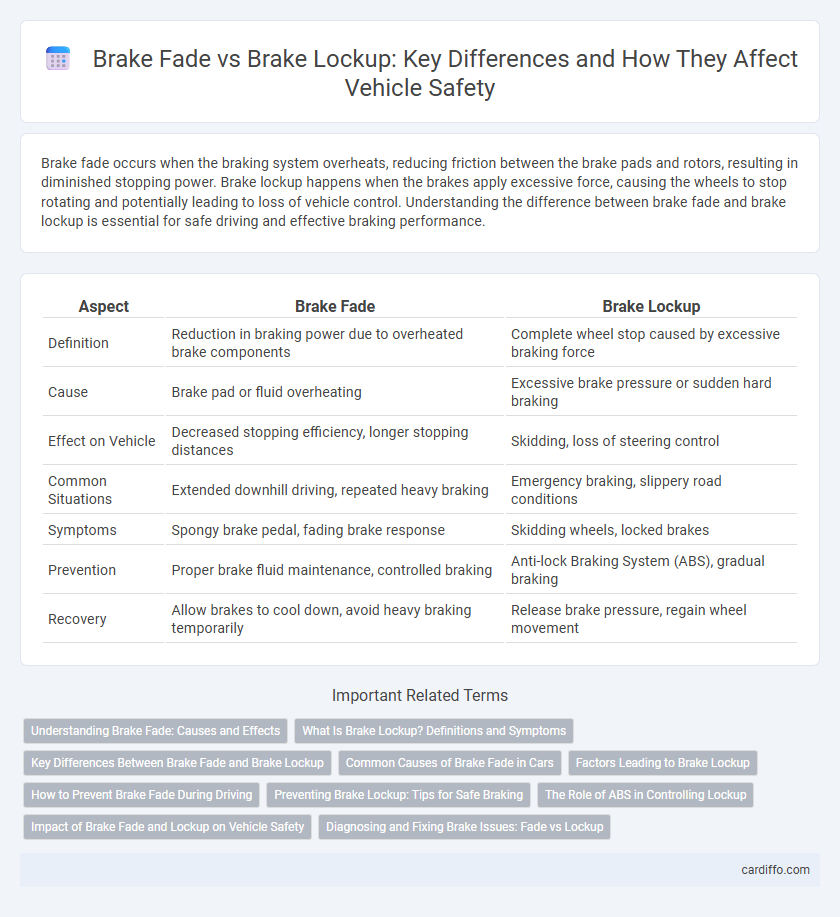Brake fade occurs when the braking system overheats, reducing friction between the brake pads and rotors, resulting in diminished stopping power. Brake lockup happens when the brakes apply excessive force, causing the wheels to stop rotating and potentially leading to loss of vehicle control. Understanding the difference between brake fade and brake lockup is essential for safe driving and effective braking performance.
Table of Comparison
| Aspect | Brake Fade | Brake Lockup |
|---|---|---|
| Definition | Reduction in braking power due to overheated brake components | Complete wheel stop caused by excessive braking force |
| Cause | Brake pad or fluid overheating | Excessive brake pressure or sudden hard braking |
| Effect on Vehicle | Decreased stopping efficiency, longer stopping distances | Skidding, loss of steering control |
| Common Situations | Extended downhill driving, repeated heavy braking | Emergency braking, slippery road conditions |
| Symptoms | Spongy brake pedal, fading brake response | Skidding wheels, locked brakes |
| Prevention | Proper brake fluid maintenance, controlled braking | Anti-lock Braking System (ABS), gradual braking |
| Recovery | Allow brakes to cool down, avoid heavy braking temporarily | Release brake pressure, regain wheel movement |
Understanding Brake Fade: Causes and Effects
Brake fade occurs when excessive heat causes the brake components, such as brake pads and rotors, to lose their effectiveness, leading to reduced stopping power. This condition often results from prolonged or intense braking, which causes the brake fluid to overheat and vaporize, creating a spongy brake pedal feel and increased stopping distances. Understanding these causes and effects is essential for preventing brake failure and ensuring vehicle safety during extended downhill driving or emergency stops.
What Is Brake Lockup? Definitions and Symptoms
Brake lockup occurs when the wheels stop rotating due to excessive brake force, causing a loss of traction and control. Symptoms include a locked wheel that skids on the road surface, a sudden loss of steering ability, and a screeching or grinding noise during braking. This condition is common in vehicles without anti-lock braking systems (ABS) and often results in longer stopping distances.
Key Differences Between Brake Fade and Brake Lockup
Brake fade occurs when the braking system overheats, reducing friction and causing a gradual loss of stopping power, while brake lockup happens when the brakes seize, causing the wheels to stop rotating and potentially leading to skidding. Brake fade is typically experienced during prolonged or heavy braking, often due to heat buildup in the brake pads and rotors, whereas brake lockup results from excessive braking force or malfunction in anti-lock braking systems (ABS). Understanding these key differences is crucial for diagnosing braking issues and ensuring vehicle safety under various driving conditions.
Common Causes of Brake Fade in Cars
Common causes of brake fade in cars include overheating due to prolonged or heavy braking, which reduces the friction between brake pads and rotors. Brake fluid boiling under extreme heat leads to vapor formation, causing a loss of hydraulic pressure and impaired braking performance. Worn brake components such as pads, rotors, or calipers also contribute to brake fade by decreasing the system's efficiency and responsiveness.
Factors Leading to Brake Lockup
Brake lockup occurs when excessive brake force exceeds tire-road traction, causing the wheels to stop rotating and skid. Factors leading to brake lockup include sudden, hard braking, low tire grip due to wet or icy conditions, and malfunctioning anti-lock braking systems (ABS). Overheated brakes can also contribute by reducing friction control, increasing the likelihood of wheel lock during emergency stops.
How to Prevent Brake Fade During Driving
Maintaining optimal brake performance requires regular inspection and replacement of brake pads and rotors to prevent brake fade caused by overheating. Using engine braking on long descents reduces continuous brake pressure, minimizing heat buildup and preserving brake efficiency. Proper brake fluid maintenance, including regular flushing, ensures hydraulic responsiveness and prevents vapor lock that can contribute to fade.
Preventing Brake Lockup: Tips for Safe Braking
Preventing brake lockup is crucial for maintaining vehicle control and ensuring safety during braking. Using anti-lock braking systems (ABS) helps prevent wheel lockup by modulating brake pressure, allowing drivers to maintain steering ability on slippery surfaces. Proper brake maintenance, such as checking pad wear and brake fluid levels, complements ABS performance and reduces the risk of brake lockup during sudden stops.
The Role of ABS in Controlling Lockup
Anti-lock Braking Systems (ABS) play a crucial role in preventing brake lockup by modulating brake pressure during sudden or intense braking, ensuring the wheels maintain traction with the road surface. Unlike brake fade, which results from overheating and reduces braking efficiency gradually, ABS actively detects wheel lockup onset and releases pressure to restore rotational control. This control mechanism significantly enhances vehicle stability and steering capability, especially on slippery or uneven surfaces.
Impact of Brake Fade and Lockup on Vehicle Safety
Brake fade reduces braking efficiency by causing a gradual loss of friction between brake components, leading to increased stopping distances and compromised vehicle control. Brake lockup occurs when wheels stop rotating during braking, resulting in loss of steering ability and increased risk of skidding or collisions. Both brake fade and lockup significantly impair vehicle safety by diminishing braking performance and increasing the likelihood of accidents.
Diagnosing and Fixing Brake Issues: Fade vs Lockup
Diagnosing brake fade involves checking for overheated brake components, glazed pads, or contaminated rotors that reduce friction and braking efficiency. To fix brake fade, allow brakes to cool, replace worn pads, and ensure proper brake fluid levels and quality. Brake lockup is identified by locking wheels during braking, often due to faulty ABS, uneven brake force distribution, or mechanical issues, and it requires inspecting ABS sensors, brake calipers, and adjusting brake pressure to restore safe operation.
Brake fade vs brake lockup Infographic

 cardiffo.com
cardiffo.com